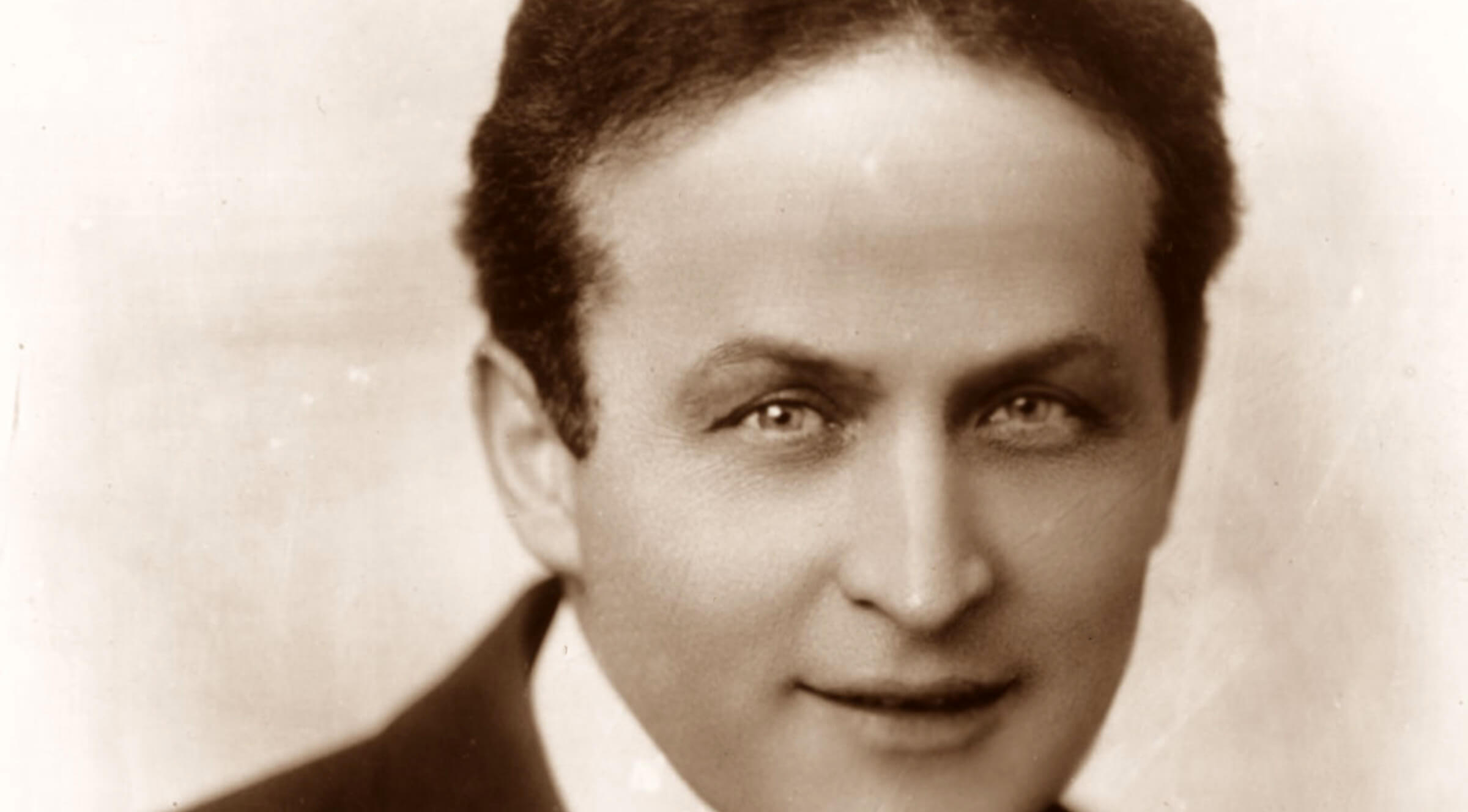This historical piece was reprinted in conjunction with the screening of The Grim Game at A Day of Silents 2015. It originally appeared in the March 20, 1920, edition of The Picture Show, which began publication in May 1919.
“Danger does not mean anything to me; I was just born without the ingredient of fear. Apart from the many risks I have taken in the course of my professional career, I have saved lives any number of times, and I have simply taken it all as a matter of course. People talk of being afraid to die; on the contrary, I am so well prepared for such an emergency that not only is my will drawn up, but I have a bronze memorial bust all ready, because, I thought it better to have one that was really like me!”
The Handcuff King
Thus spoke Houdini, the “handcuff king,” the great magician and genius of escape on a certain sunny morning a few weeks ago. He sat with his back to the light, but though his face was in shadow the compelling blue grey eyes and strong, bronzed features glowed with an intensity and vitality such as one rarely meets.
“Tell me,” I begged, “are the feats you do on the screen different to those you do enact before the footlights?”
“Entirely different,” was the reply.
“In fact, some of the biggest critics have said that I am more wonderful on the screen than on the stage. That, I consider is one of the greatest compliments ever paid me. But it has taken years of training to produce the tricks, or problems, I do in my films.”
Houdini has made to date, three pictures. The first of these, “The Master Mystery,” a serial, is now enjoying enormous popularity all over the country. The remaining two, “The Grim Game” and “Terror Island,” are feature pictures and are still unreleased by Paramount Artcraft though this year will see the first-named on our screens. In the making of “The Master Mystery,” Houdini sustained seven black eyes and a broken wrist. He also broke his wrist whilst making “The Grim Game.”
A Tense Moment
“During the screening of this picture I thought at one time in the course of the action, that my end had come,” he told me. “I was 3,000 feet up in an aeroplane, circling over another machine. The plan was for me to drop from my ’plane into the cockpit of the other by means of a rope. I was dangling from the rope-end ready for the leap. Suddenly a strong wind turned the lower plane upwards, the two machines crashed together—nearly amputating my limbs—the propellers locked in a deadly embrace, and we were spun round and round and round.” Houdini pronounced the latter words with a peculiarly apt “whirring” intonation, graphically illustrating them by the circular action of the arms. “But,” he continued, “by a miracle, the planes were righted into a half-glide, and though they were smashed into splinters by their terrific impact, I managed to escape unhurt. As usual, Houdini became undone!” concluded the narrator with a laugh.
His Greatest Stunt
“What do you consider the greatest stunt you have done for the screen?” I asked, when I had recovered my breath.
“Another incident in the same picture,” answered Houdini. “I stood in the archway of a prison, thus.” Here he took up a crouching position in the corner of the room, and enacted the whole thing for my benefit. “A heavily loaded lorry, going at twenty-two or -four miles an hour rolled by me. I threw myself on the ground, completely rolling over between the fast revolving fore and hind wheels, over and over, till I caught the transmission bar, and hung there for very dear life! Thus was I carried to the aid of the heroine. Though my words may not convey very much, this was my greatest stunt. It allowed for no rehearsals—I said to the camera-man, ‘Get this now or never!’ And had I made the slightest false move, I should have been crippled for life, if not killed.”
In spite of the risks he has taken before the camera, Houdini has a profound love and admiration for the “movies.”
“I think the film profession is the greatest,” he told me, “and that the moving picture is the most wonderful thing in the world. One reason why I love the screen is because it has use for the derelicts of life, and gives employment to the old as well as the young. I entered the profession myself because I knew I should eventually be losing my strength, and before that happened I wanted to perpetuate my feats, and by so doing everyone, in all parts of the world, can see them. Pictures have increased my drawing power two-hundred fold.”
Houdini, as related at the commencement of this chat, had one of his greatest compliments paid him by critics of his film work, but before I left him he confessed that what he considers the very greatest tribute ever made to his unique achievements is recorded in a dictionary! Turn to Funk and Wagnall’s Standard Dictionary, and there you will find it:
“HOU’DI-NI. I, hn’di-ni;
2, hn’di-ni, HARRY (4-6, 1874).
American mystericist, wizard, and
expert in extrication and self-re-
lease HOU’DI-NIZE vt. To re-
lease or extricate oneself from
(confinement, bonds, or the like),
as by wriggling out.”
So, taking Houdini all in all, I may consider the fact that this wonder-man, this “expert in extrication” made no effort to escape from at least one thing, this interview!

